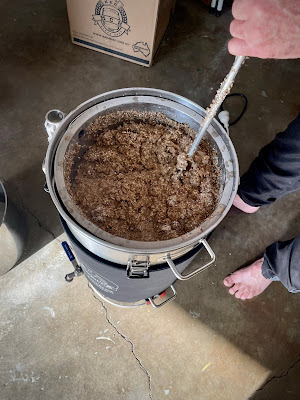After a few uses of our RAPT Temperature Controller, as a matter of interest we decided to check it's accuracy to ensure we were actually fermenting at the temperature we had set on the controller.
Much to our surprise we discovered that the RAPT Temperature Controller was a whole 3°C off when compared to both our Inkbird Temperature Controller, and a stand alone Weber branded meat thermometer.
After inserting the probe for the Inkbird into the same location directly next to the probe for the RAPT Temperature Controller on our fermenter, we had a reading of 23°C on the Inkbird and 19.9°C on the RAPT. Our Weber probe thermometer had the same reading as well at 23°C.
Since both the Inkbird and Weber thermometers reading the same temperature, the RAPT Temperature Controller was the outlier and therefore presumed to be inaccurate.
To be clear, we never bothered to run a calibration on the RAPT Temperature Controller - but then again we never calibrated our Inkbird controller either and it seems to be very accurate.
Looking at the instructions for the RAPT Temperature Controller - it has details on how to perform a calibration but suggests you use ice water in one glass, and "hot" water in another.
We initially attempted running the calibration against ice water, and near boiling water which improved the accuracy but it was still around 1.5°C out at the temperature range we really need to measure (around 18°C - 20°C).
We got better results by calibrating against ice water, and another "warm" water solution at around 30°C which got us to within 0.4°C which for us is close enough.
Here's the process for calibration;
Setup two glasses of water - put some ice in one (to make it as close to 0°C as possible) and another with warm tap water - around 30°C.
You will need another (accurate, previously calibrated) device to measure the temperature of the water to calibrate the RAPT Temperature Controller against - for us we will be using our Weber meat thermometer.
Put the second thermometer and sensor probe for the RAPT Temp Controller into the ice water solution first.
You can see when we did this our RAPT Temperature Controller is reading -1.9°C compared to 0.2°C from our meat thermometer.
Press the Enter button on the RAPT Temperature Controller to open the menu, then press the Down arrow to highlight Settings, then press the Enter button again to open the Settings menu.
Use the Down arrow to scroll through the options and locate the option for 2 point calibration. Press Enter to select the 2 point calibration option.
The calibration screen will now be displayed for calibration point 1. Make sure the probe is fully submersed in the ice water and wait for the number next to ADC Reading to stabilise.
Once the ADC Reading number has stabilised, use the Up and Down arrows on the RAPT Temperature Controller to adjust the Temperature value so it matches the value on your other thermometer. In our example below, we set the RAPT Temperature Controller to a temperature of 0.2°C to match the temperature reading on our meat thermometer.
Press Enter to complete the calibration for calibration point 1.You will now be prompted to repeat this step for a second, warmer solution for Calibration Point 2. Repeat this process in your other water solution after moving the temperature probe and your second thermometer and press Enter to finalise the calibration once you've adjusted the temperature to match.
Once completed you are returned to the menu screen - there's no other confirmation messages or anything to say the calibration has been completed.
As previously stated, we got more accurate results by calibrating against a second solution at around 30°C. We were still almost 0.5°C out though, so for the best accuracy we'd recommend calibrating against ice water and a warm solution at around 20-25°C.
So if you have a RAPT Temperature Controller and haven't calibrated it yet, it's well worth investing the time to do so. Temperature control is known to be such a crucial part of fermentation and ensuring the best possible product being produced by your yeast.
PS: we hope you enjoyed the above article and thank you for reading this far! If you found this article useful, please consider subscribing using the in-page sign up window. It really helps us grow the site, and you'll get a single email from us weekly with links to our latest and greatest content, that's all! Thanks again for checking out our blog.










.png)
























